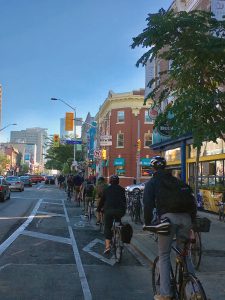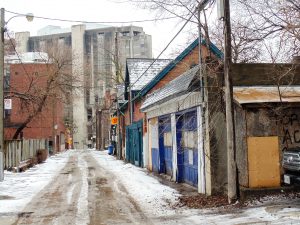A celebratory year in review

GEREMY BORDONARO/GLEANER NEWS Ten Editions Bookstore (698 Spadina Ave.) is at the centre of tension between town and gown. Heritage Preservation Services has recommended adding the building to the city’s protected list of heritage sites, but the university wants to tear it down to make way for a new student residence at Spadina and Sussex avenues.
By Annemarie Brissenden
Is it possible that we just like cake?
Because it seems that we just couldn’t stop celebrating this year. Maybe all the calamity outside our borders made our small local victories all that sweeter. But from bike lanes to major anniversaries to plaque unveilings to greener parks, we had a lot of reasons to indulge our sweet tooth this year.
Even as we pushed back against increasing density, we’re slowly getting better at working with each other to keep our neighbourhood a neighbourhood. We’re also reclaiming an inclusive heritage that’s more respectful of our past. While the Family Compact still features prominently on our streets and in our buildings, Anishinaabe names are clamouring to join them. We’ve unveiled a plaque to Albert Jackson, Canada’s first black postman, and are continuing to bring Jewish and Chinese history into the official narrative of our past. It’s about time — history can no longer be a received narrative written by the so-called victors.
That in and of itself is a reason for cake. So, grab a slice of something sweet, and join us as we bring you this year’s iteration of a December tradition: our annual year in review.

COURTESY ANDRE VALLILLEE Considered by many as a major victory for the area and for cyclists generally, the Bloor Street bike lanes, which run from Avenue Road to Shaw Street, are now a permanent feature of our community.
Riding to victory
It’s taken 40 years, but we finally got them: permanent bikes lanes on Bloor Street from Avenue Road to Shaw Street. A study sponsored by local business improvement areas demonstrated that businesses along Bloor Street do not suffer because of the lanes, and that the bike lanes are a popular, safe thoroughfare for many cyclists. For a city that needs to rethink transit and its transit infrastructure — there’s way too much focus on cars, and, as everyone knows, public transit is bursting at the seams — the lanes are a major victory.
Academic tension
With the downtown campus of Canada’s largest university sitting on the southeastern corner of the Annex, there’s bound to be some tension between town and gown. And this year was no exception. While the university opened the restored 1 Spadina Crescent, the university’s beautiful new home for the school of architecture and design — a stunning mix of old and new that is as much a gateway to the Annex as to the campus itself — neighbours were suspicious of attempts at community outreach. Plans to build a student residence at Sussex and Spadina avenues — which would see a much-loved heritage-listed bookstore torn down — and the school’s request to have a planning exemption for a broad swath of midtown gave many pause.
The next Westbank
After years of speculation and uncertainty, the Bloor Street United Church has revealed its plans to redevelop its site, which, admittedly, is due for an upgrade. The initial proposal calls for a 38-storey mixed-use tower to be built on site, which will presumably pay for renovating and restoring the century-old church, whose main steps and entrance were truncated in 1927 to make way for the widening of Bloor Street. Like Westbank Projects Corp. before them, the developers have begun consulting with the community before submitting their application to the City of Toronto, and like Westbank, have faced resistance from neighbours concerned about density and height. However, we wonder if it’s time to set aside our fear of towers, and start to think more about how to transform Bloor Street into a grand avenue that accommodates multiple modes of transit, lots of light, many swaths of green, and lots of independent retail and dining options.

BRIAN BURCHELL/GLEANER NEWS As density increases, we need to think more creatively about how to integrate more people into our neighbourhood. Two city councillors have argued that making laneways, like bpNichol Lane, available for housing might be one solution.
Damn that density
At the heart of every community meeting on a new development proposal are concerns about how increased density will impact our neighbourhoods. Residents are right to be concerned. There doesn’t appear to be a plan for delivering increased services, or even some explanation of how everyone will fit on the subway during rush hour. But that doesn’t mean we should treat every new development with suspicion, demonize those who favour renting over buying, and ignore the fact that we’re bound to share our space with more than our share of students, given our proximity to so many universities and colleges. If we have to absorb greater density, let’s stop fighting that, and start fighting for better ways to integrate young and old (buildings and people alike). Some enterprising folks have suggested laneway living as an alternate to building tall towers, which we, despite the Harbord Village Residents’ Association’s (HVRA) longstanding policy against it, think worthy of exploration. We can be welcoming when we want to — consider how we welcome refugees and new immigrants. After all, a classic bay and gable is becoming increasingly out of reach for most people, and if the projections are correct, many of us will be closing out our years in an apartment or smaller dwelling of some sort.
To those who came before
As we grapple with how to absorb so many newcomers to our neighbourhoods, we should look to those who came first: our Aboriginal and Indigenous residents. The Annex sits in the heart of a what was once a major route for Indigenous peoples, and, thankfully, we’re starting to reclaim that past. The Dupont by the Castle BIA worked with the Ogimaa Mikana project to install permanent Anishinaabe signs on major streets in the Dupont area. This summer also saw Toronto host the Indigenous Games, and the Royal Ontario Museum mounted an exhibition of Indigenous artifacts that were unearthed from numerous locations throughout the city. These are small steps towards reconciliation, steps that could grow by launching an Indigenous Affairs Office at city hall.

GEREMY BORDONARO/GLEANER NEWS Margaret Fairley Park was one of three parks that were upgraded this year. With fewer and fewer people having access to their own backyards, green space is becoming more important than ever.
Moving to a greener Annex
Our green space got a bit of a boost this year. Three park revitalizations — the Doctors’ Parkette on College Street, Margaret Fairley Park on Brunswick Avenue, and Bickford Park on Grace Street — were completed. As density increases in the neighbourhood, and fewer people have less green space to call their own, such urban oases aren’t so much a luxury as a necessity. The Palmerston Area Residents’ Association, following a model set by the HVRA, also launched its own green plan process, and the Bloor Annex business improvement area shared its vision for street revitalization that will transform four unused rights-of-way at Howland Avenue, Brunswick Avenue, Major Street, and Robert Street into parkettes with granite seating, trees, and pollinator-friendly gardens.

GEREMY BORDONARO/GLEANER NEWS Harbord Collegiate Institute teacher Belinda Medeiros-Felix and student volunteers prepared to celebrate the school’s 125th anniversary in the spring. Memorabilia is on display in the school’s museum, the first of its kind in Canada.
Marking more than 150
As the nation celebrated its sesquicentennial, we marked a few major, local anniversaries. The Women’s Art Association of Canada — whose founder Mary Ella Dignam had close relationships with members of the Group of Seven and twice welcomed Emily Carr to Toronto — celebrated 130 years at its annual garden party in June. Harbord Collegiate Institute marked 125 years with a little of Oola and a lot of Boola in May. The school, which launched the careers of Wayne and Shuster, is the third oldest in the Toronto District School Board. In Seaton Village, Karma Co-op celebrated 45 years of sharing food, and in these pages we did a retrospective of cartoonist Brett Lamb’s 20 years at the Gleaner. Finally, the Bloor St. Culture Corridor, whose executive director Heather Kelly writes an arts column in this paper, celebrated three years. More than three million people visit the arts and culture organizations in this unique corridor every year.
READ MORE:
YEAR IN REVIEW: A focus on livability, grindertude (DECEMBER 2016)
YEAR IN REVIEW: Grassroots activism marks annual review (DECEMBER 2015)
